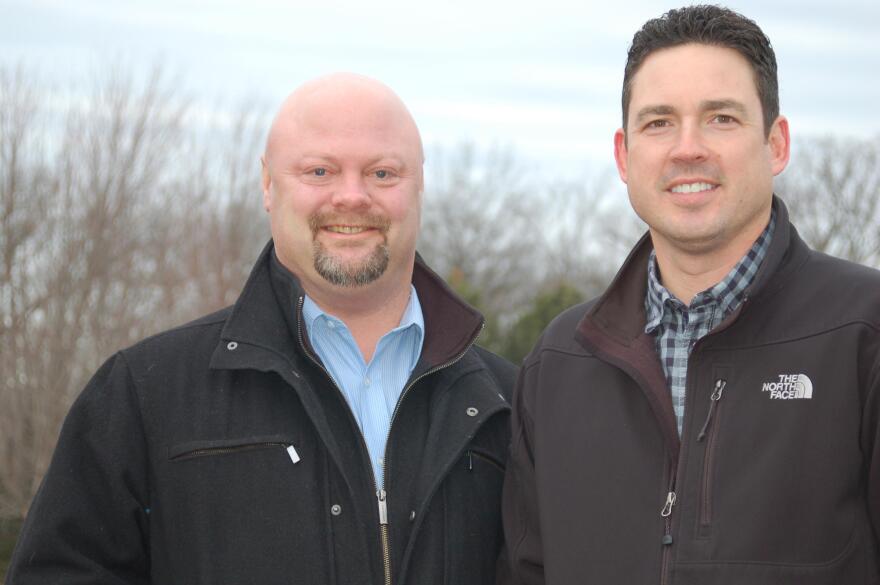If you find an injured raptor in eastern Iowa, there’s a place to take it. Two people have established a new raptor rehabilitation center because they felt there was a lack of medical resources for injured birds in the area.
The new center is called RARE, which stands for Raptor Advocacy Rehabilitation and Education, and it’s based in Iowa City. It is so new the operators don’t even have their own facility yet. They are using donated space at a couple of veterinary clinics. Recently, two birds were brought in for X-rays: A woodland bird called a Cooper’s hawk was found tangled up in a chain link fence in Dubuque, its wing badly fractured; and a little screech owl found in the middle of a road in Fairfield with head trauma.
“You can see where the shoulder is really messed up there," said RARE co-founder Jodean Cancilla, reading the hawk's X-ray. "You can see where the little ball is right there. But then it’s broken in two pieces right a long there, a third piece there."

Unfortunately, the Cooper’s hawk’s injuries were too severe, and it had to be euthanized.
“The way that we can look at it,” says Cancilla, “is that this bird will not die a slow death out in the wild. It will not suffer, it won’t starve to death out there it won’t become prey for another predator.”
The little screech owl has a leg fracture and trauma to its eye. Later, it’s decided that the bird will not be released back into the wild, but can be used as an educational bird elsewhere in the state.
Cancilla worked for an eastern Iowa educational wildlife center, MacBride Raptor Project, for almost 30 years, where she helped establish its raptor rehab program. Now in retirement, she’s helping forge RARE, after MacBride dropped its program to focus on research.
“They didn’t want to do rehabilitation any longer and we felt that there was really a strong need and took it over,” she said.
RARE’s director and co-founder Luke Hart says on average, they’re taking in one bird every other day, and they document every case that comes in for their own records and for research.

“We can go back to our cases and say this one was released, this one wasn’t and we can look at day to day treatment to see if there’s a pattern or what kind of treatments are really working well, what aren’t,” he says.
It’s not just injured birds that benefit from the care of rehabbers. Bruce Ehresman is an avian biologist with the Iowa Department of Natural Resources. He says sick animals can give an indication of what’s happening to the greater population, and it's thanks to raptor rehabilitation that we have a better understanding of the magnitude of diseases such as West Nile virus and Avian Flu, as well as lead-poisoning in bird populations.
“For instance, when West Nile virus arrived in the early 2000's, lots of great horned owls and red-tailed hawks came in lots more than we were typically documenting," he says. "That was a kind of a red flag that certain species were being impacted perhaps more than others. “
And, he says, raptor rehabilitation also has been instrumental in successful reintroduction efforts, like the peregrine falcon.
“And we had a fair percentage of those birds when they start flying would fly into buildings and so we depended upon wildlife rehabilitators to be able to treat those birds and get as many back into the wild as possible," he says.
Recently, a red tailed hawk got the chance to be returned to the wild, thanks to Chad Hartke and Matt Patton. They work at Limolink in Marion.

“Matt and I were having a meeting and we heard a loud thud on the window and we happened to see this hawk out there," Hartke said. "We went out and we put in some grass and thought you know maybe it’s knocked out it’ll come to.”
They called RARE and were instructed to put the hawk in a box with air holes, and they met up with Luke Hart. He says the bird was treated for a head injury.
“We gave some anti-inflammatories to take down any swelling that might have been on the brain, fluids, rest, food," he said. "It’s taken a while but she’s back to normal.”
A month later, Chad and Matt took part in releasing the hawk into a woodland not far from where they rescued it.
In their first four months in business, RARE has already cared for forty-five birds. They hope to have their own facility someday complete with flight cages to exercise recuperating birds.




